Your Cart

Identifying Common Lawn Diseases
Apr 09, 2025
Causes: Dollar Spot is caused by the fungus Sclerotinia homoeocarpa, which thrives in warm, humid conditions and spreads through the grass blades by contact or through the air. It can also be spread by mowing equipment, shoes, and other lawn tools.
If you suspect that any of the diseases or insects listed above are affecting your lawn, contact your local Weed Man for a diagnosis and customized treatment recommendations.
Is your lawn looking patchy, discolored, or off in some way? When lawn disease strikes, your lawn can undergo extensive damage in a short period of time, so It’s important to act quickly to identify the disease and control it before it spreads across your property.
In this guide, you’ll find all the basics about common lawn diseases in southern regions, including symptoms and underlying causes.
Brown Patch
.jpg) Description: Brown Patch is a leaf disease that can appear on your lawn during periods of hot and humid weather. Brown Patch will often appear first as rough, circular patches varying in size, from a few inches to several feet across. In the early morning dew, you may notice something that looks like purple or grayish-brown cobwebs; this is actually fungal growth. While the disease rarely causes damage to Kentucky Bluegrass, it can cause significant damage to Tall Fescue, Perennial Ryegrass, and Creeping Bentgrass.
Description: Brown Patch is a leaf disease that can appear on your lawn during periods of hot and humid weather. Brown Patch will often appear first as rough, circular patches varying in size, from a few inches to several feet across. In the early morning dew, you may notice something that looks like purple or grayish-brown cobwebs; this is actually fungal growth. While the disease rarely causes damage to Kentucky Bluegrass, it can cause significant damage to Tall Fescue, Perennial Ryegrass, and Creeping Bentgrass.
Causes: Brown patch is caused by the Rhizoctonia fungi, which infects the grass foliage and crowns. This fungus colonizes the organic matter in the thatch layer, and, during times of stressful conditions, can cause disease in the grass plant. Brown patch is likely to develop in cool season grasses when temperatures are above 85°F with high relative humidity.
Dollar Spot

Description: Dollar Spot is a fungal disease that can affect residential lawns, particularly those with cool-season grasses like Kentucky Bluegrass, Perennial Ryegrass, and Fine Fescue. It’s called Dollar Spot because the affected areas typically show up as straw or tan colored spots that are small, round, and the size of a silver dollar. The spots may also have a reddish-brown border. In severe cases, the spots may merge and form larger patches of dead or dying grass.
Causes: Dollar Spot is caused by the fungus Sclerotinia homoeocarpa, which thrives in warm, humid conditions and spreads through the grass blades by contact or through the air. It can also be spread by mowing equipment, shoes, and other lawn tools.
Fairy Ring
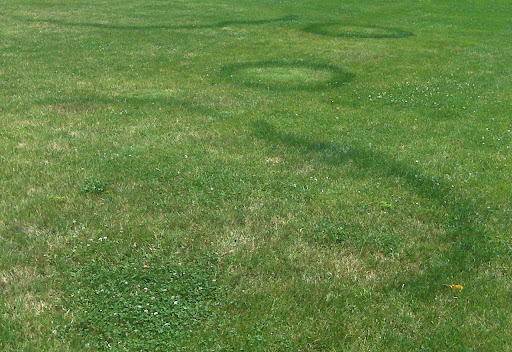
Description: Fairy Ring disease is recognized in early summer by the appearance of dark green, circular bands in the lawn. Most of the time, Fairy Ring forms in a circular pattern, but it’s also common to see an unformed circle. Bands can vary in width from 4-12 inches, and rings can vary in diameter up to 50 yards. During periods of wet weather, mushrooms and toadstools may rise along the circumference of the rings.
Causes: Fairy Ring is caused by a fungus called Marasmius oreades, also known as the Fairy Ring Mushroom. The fungus is contained within the soil, as deep as 12 inches below the surface, and creates mushrooms that can range in size from a few inches to several feet in diameter. It attacks at a central point and grows outward along the inner margin of the rings, where the grass becomes very weak and often dies out temporarily. In small rings, the weakened grass may occupy the entire central area. The fungus feeds on dead organic matter in the soil and can also affect the growth of the grass, causing it to be thicker or thinner than the surrounding grass. High soil moisture, poor drainage, and the presence of dead organic matter, such as leaves or tree stumps, can contribute to the development of Fairy Ring.
Gray Leaf Spot
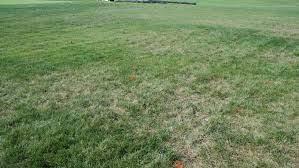
Description: Gray Leaf Spot is a fungal disease that tends to affect warm-season grasses, such as Bermuda, Zoysia, St. Augustine, and Tall Fescue, in the warm and humid regions of the United States. The disease appears on the leaf blades of the turf as circular or oval-shaped, tan-colored lesions with brown or purplish borders. In severe cases, lesions can develop on leaf
sheaths and stems and the leaves will wither and die. As the disease progresses, the affected area will grow larger and the grass will begin to thin out, turn brown, and die, sometimes killing large areas of the lawn. Unless the disease is controlled, it can cause devastating damage.
Causes: Gray Leaf Spot is caused by the fungus Pyricularia grisea, which thrives in warm and rainy climates.
Leaf Spot
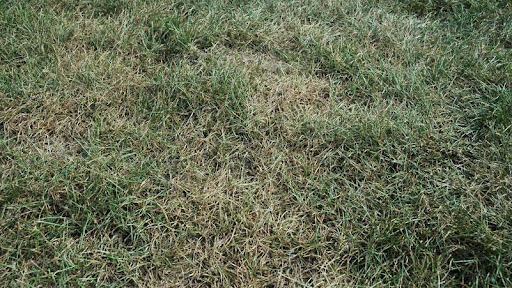
Description: Leaf Spot is often grouped with Melting Out disease, due to their similar symptoms and effect on turfgrass. Leaf Spot will appear as small, circular or elongated spots on the leaves of the grass plant. These spots are typically brown or tan in color, with reddish or purplish borders. As the disease progresses, the spots may enlarge and merge together, eventually causing the grass blades to turn yellow or brown and die.
Causes: Leaf Spot is often caused by a pathogen that does the most damage during the heat of the summer months.
Powdery Mildew
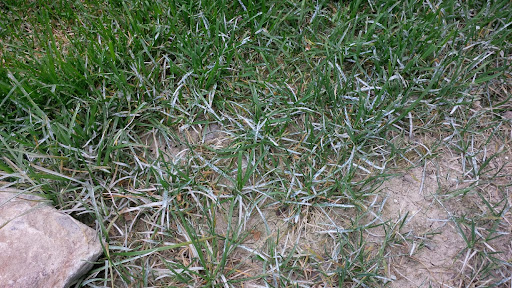
Descriptions: Powdery Mildew is a fungal disease that can infect any turfgrass, but is most common on Annual Bluegrass, Bentgrass, and Fescues. The fungus causes a white or grayish powdery coating to appear on the leaves and stems, feeding on the plant tissue and causing damage. The affected leaves may also turn yellow or brown, and the grass may become stunted and weakened.
Causes: Powdery Mildew occurs in cool, humid conditions, most commonly in the spring and fall when temperatures are between 55°F and 70°F. It can spread rapidly in heavily shaded areas, periods of low light intensity, and periods of poor air circulation.
Rust
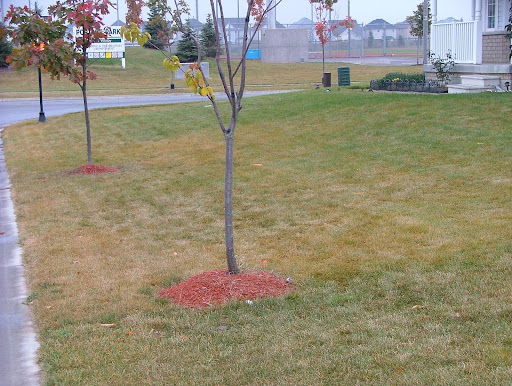
Description: Rust is a fungal disease that affects many types of turfgrasses. It is appropriately named for the orange or brown rust-colored spots it produces on the grass blades. The disease can cause the leaves of grass plants to turn yellow, wilt, and die, leading to thin and patchy lawns. Rust favors warm and wet conditions, occurring most prominently in late summer and fall, when there are conditions of low light intensity and temperatures between 70°F and 80°F.
Causes: Rust is caused by a group of fungi commonly found in soil and plants. It survives on living and dead leaf tissue in the thatch layer of the lawn. When conditions become suitable, the disease will occur quite rapidly. A variety of factors can contribute to the growth of Rust, including improper watering, high humidity levels, and fluctuating weather patterns. Reddish orange spores develop in large numbers on the leaves of the grass plants and are easily rubbed off on shoes, clothing, animals, mowing equipment, or other objects that pass through the infected areas. However, as conditions improve and cultural practices are altered, the grass is normally able to recover.
SUMMER PATCH
.jpg)
Description: Summer Patch is a disease that affects cool-season grasses, such as Kentucky Bluegrass, Tall Fescue, and Fine Fescue. As the name suggests, it typically occurs during the hot and humid summer months, particularly in areas with poor soil drainage or heavy thatch buildup. Symptoms include yellowing and browning grass with patches of dead or dying turf. These patches may be circular or irregular in shape and can range in size from a few inches to several feet in diameter.
Causes: Summer Patch is caused by a fungus called Magnaporthe poae, which attacks the roots and crown of the turfgrass plant. Damage from this disease will often occur where the grass receives direct sun and is located on south-facing slopes or near sidewalks, driveways, buildings, or otherwise stressed areas. In the cool weather of autumn, the grass may begin to grow into these dead areas again.
Managing Chinch Bugs in Your Lawn
Are you constantly watering your lawn, yet it still appears dry? Does your lawn have irregular yellow patches or brown spots? You may be dealing with a chinch bug infestation.
WHAT ARE CHINCH BUGS?
Chinch bugs are small insects that live in and feed on lawn grasses. They live above the soil and feed on living grass plants by means of a piercing mouthpart called a stylet (similar to a mosquito). The insect inserts its stylet into the leaves, stems, or crowns of the lawn grasses and sucks the juices out of the plant.

Chinch bugs have a gradual life cycle with three stages: egg, nymph, and adult.
Chinch bug eggs are white in color, though they turn orange just before hatching. The eggs are bean-shaped, with one blunt end and one pointed end.
When the eggs have hatched, the chinch bugs enter the nymphal stage. There are five nymphal instars within this stage, all of which vary in appearance. In the first instar, the nymphs have an orange body with a cream-colored stripe, along with a brown head and thorax. In the second instar through to the fourth instar, the orange colour turns to a purple or grey colour with two black spots, and the nymphs slowly increase in size. In the fifth and final instar, the nymph turns black and wing pads become visible, as the length of the nymph grows to 3 millimeters.
In the adult stage, chinch bugs grow to be about 3.5 millimeters long and 1.75 millimeters wide. The majority of the body is grey or black and covered in hairs, aside from their wings that are white with a black spot in between, and their legs that are dark orange in color. Adult chinch bugs become active when daytime temperatures reach 70 degrees Fahrenheit, or 21 degrees Celsius. In the springtime, the female chinch bugs will lay up to 200 eggs within the folds of the grass blades or into the thatch. Eggs can hatch in as little as one week.
WHAT DOES CHINCH BUG DAMAGE LOOK LIKE?
Chinch bug damage looks quite similar to drought symptoms: dry, yellow or brown patches. Unlike with periods of drought, however, watering will not remedy the damage caused by chinch bugs.

HOW DO I TREAT FOR CHINCH BUGS?
Leaving chinch bug damage undiagnosed for too long can lead to complete turf destruction in a matter of weeks, meaning expensive and unexpected lawn repairs in your future. Promptly treating chinch bug infestations can help protect the investment you have made in a lawn care program and your property.
Managing Armyworms in Your Lawn
Are you noticing brown patches of grass in your lawn? Do the edges of the grass blades appear to be chewed in these patches? If so, you may be dealing with an armyworm infestation. Because these insects are extremely destructive, identification and quick treatment are absolutely crucial.
What are armyworms?
Contrary to what the name suggests, full-grown armyworms are not actually worms – they are moths. Before reaching full maturity, however, armyworms do resemble worms in their larval stage, and these worm-like pests can cause serious damage to the lawn.
Armyworms get their name from the way that they “march” across turf grass in an army-like fashion. When larvae consume available food sources, they migrate as an army to new host plants.
These bugs are native to North America and can be found east of the Rocky Mountains, reaching into southern Canada.
What do armyworms look like?
Armyworm larvae vary in color from dark greenish-brown to black. They have long white, orange, and dark brown stripes along the length of the abdomen.

Mature larvae are approximately 1.5 inches long. The head capsule is a yellowish-brown with a brown network of veins, which gives the armyworm a mottled appearance.
Armyworm life cycle
Armyworm moths migrate from the southern U.S. states in April and May. They are active during the evening, feeding on nectar, mating, and searching for areas – like your lawn! – to lay their eggs.
Armyworm eggs are deposited in rows or clusters on the lower leaves of grasses or at the base of plants; these typically hatch in one to two weeks, beginning the larval stage.
During the daytime, armyworm larvae can be found under plant debris, or in the top few inches of the soil. Armyworm larvae are active at night, feeding on turf grass plants. This is the cause of the damage that homeowners tend to see on their lawns, which results in brown patches in the lawn.
After completing six instars, larvae pupate just below the soil surface. Adults emerge in one to two weeks. A second generation will occur in late June or early July, followed by a third in late August or early September.
What can be done about armyworms?
Promptly treating potentially devastating armyworm infestations can help protect the investment you have made in a lawn care program and your property. If you notice suspicious brown patches starting to appear in the lawn, contact your Weed Man Professional as soon as possible to minimize damage. Weed Man can verify the presence of an infestation, discuss preventative measures, and recommend treatment if required.
A thick, healthy, well-maintained lawn is always the best defense against lawn disease. In most cases, the spread of the disease will be reduced by changes in temperature and weather, but you can also adjust some cultural practices to improve the health of the lawn and limit the spread.
Avoid watering when lawn disease is active.
Avoid mowing when lawn disease is active. If you do have to mow, make sure the blades are sharp to minimize the spread of disease.
Fertilize regularly.
Aerate to improve soil drainage, reduce soil compaction, and allow water and nutrients to penetrate the soil, reducing the likelihood of lawn disease.
If you suspect that any of the diseases or insects listed above are affecting your lawn, contact your local Weed Man for a diagnosis and customized treatment recommendations.
